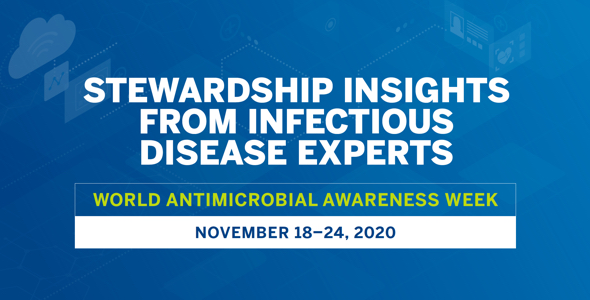By the bioMérieux Connection Editors
World Antimicrobial Awareness Week is just around the corner! Learn more about the importance of understanding antimicrobial resistance (AMR) and combatting it through stewardship initiatives. Hear from infectious disease expert, Ravina Kullar, PharmD, MPH, FIDSA about the significant threat of AMR and what can be done to stop it. Then, learn from Chris Bland, PharmD, BCPS, FIDSA, FCCP about what makes an effective antimicrobial stewardship team and how impactful timely diagnostic results can be.
Why is antibiotic resistance such a significant threat?
Infections caused by antimicrobial resistant pathogens can be difficult or in some cases impossible to treat. This has caused AMR to become one of today’s most serious public health threats. It is projected to take more than 10 million lives annually by 2050 if we do nothing to stop it. Working together is part of the solution, according to Dr. Kullar. Teamwork will help us have a future where antibiotics can still be used to save lives.
How is antimicrobial resistance limiting our options to treat bacterial infections?
Because of antibiotic misuse and overuse, patients can develop infections that are resistant to multiple, or occasionally all, available antibiotics. Each year in the U.S., at least 2.8 million people are infected with antimicrobial-resistant bacteria or fungi, and more than 35,000 people die as a result.
What can be done to combat antimicrobial resistance?
Dr. Kullar discusses four ways to combat AMR, including timely diagnostics, treating the infection with the right antibiotic duration, education about the consequences of inappropriate antimicrobial use, and infection prevention. Each of these areas can help in the fight to preserve the efficacy of our antimicrobials.
What are key strategies that can drive antimicrobial stewardship (AMS)?
According to Dr. Bland, leadership and communication have the power to drive stewardship and make a difference. Many stakeholders are involved in antimicrobial stewardship programs (ASP), including nurses, pharmacists, and microbiologists. A leader can help stakeholders come together and improve their communication—a critical component of an effective team.
How do timely diagnostic results support antimicrobial stewardship initiatives?
With new technology, clinicians can acquire valuable diagnostic results much faster than in years past. When paired with an antimicrobial stewardship program, fast and accurate diagnostic results can also help combat AMR. Timely diagnostic results allow providers to optimize treatment methods and ensure any antimicrobial treatment is appropriate for the patient’s condition. Especially for severe infections, accurate and rapid bloodstream pathogen identification and antimicrobial susceptibility testing has positive effects on clinical outcomes.
You can continue to learn more about AMR and what can be done to stop it by visiting the CDC’s antimicrobial resistance resource page. Fighting this global public health threat requires a collaborative approach that includes all of us.
Opinions expressed in this article are not necessarily those of bioMérieux, Inc.



